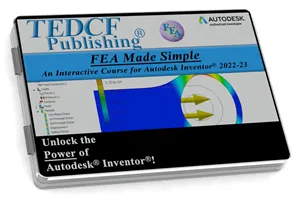Yes, you too can use Finite Element Analysis (FEA)!
The Inventor 2022: FEA Made Simple course shows you how to unlock the power of design analysis. You will learn how Inventor analyzes each element of your design and how information propagates from element to element. So you will study FEA from both macroscopic and microscopic perspectives.
Almost all FEA documentation these days uses heavy matrix mathematics and advanced concepts to explain how it works. This course does just the opposite. It uses simple math and simple examples to give you a clear understanding of what you need to know. The result is you will be able to analyze your designs with just as much confidents as anyone.
So how do we know what you need to know? Using FEA is a little like knowing how to drive a car. If all the driver's training schools taught air/fuel ratios and fuel injector design you know that is not required to be a good driver. It's unfortunate, but FEA is typically taught with overly complicated concepts and heavy math that is not required to use it effectively.
Our instructor is a licensed Mechanical Engineer who knows the heavy math and advanced concepts. He also knows what you need to know to use FEA effectively. So he's broken the process down into simple to understand steps. When math is used it's simple. No calculus or matrices, just simple algebra and simple equations. He knows what you need to know to be accurate and effective. So the course is simple and easy to understand.
Produced for Autodesk Inventor 2022, the FEA Made Simple course is all you need to learn how to use this powerful tool.
58 Lessons (Listed Below)
5 hours of instruction
You can also browse through the lessons from the following Inventor 2022 courses and watch sample lessons.
Inventor 2022: Solid Modeling Inventor 2022: Assemblies and Advanced Concepts Inventor 2022: 2D Drafting and Customization Inventor 2022: Sheet Metal Design Inventor 2022: Tube and Pipe Routed Systems Inventor 2022: Inventor Studio Made Simple Inventor 2022: iLogic Made Simple Inventor 2022: Fea Made Simple Inventor 2022: Dynamic Simulation Made SimpleOur Inventor courses require No Installation. You can watch them on any device connected to the internet.
You will receive an email containing your User Name and Password. Login to your account and start learning. It's that easy.
While you're logged into your account you can download files used in the courses, watch lessons, and practice the tasks taught in the lessons. Keep in mind that you will use your installation of Inventor to practice.
Get your Inventor 2022 training now. You can start learning in minutes.
Autodesk Inventor® 2022:
FEA Made Simple
No Installation Required
Watch from any device connected to the internet.

$59.95 - $229.95
Watch Sample Lessons
Watch the first hour of the Solid Modeling course for Autodesk Inventor 2022.
 Click to Watch!
Click to Watch!FEA Made Simple
5 hours of instruction
Lessons
Introduction
Simulation Setup
Basic Static Simulation
Basic Static Simulation Results
Normal Stress
Shear and Normal Stresses
Components of Force
Principal Stress Intro
Controlling Probe Location
Mohr's Circle
Maximum Shear Stress
Principal Stresses
Von Mises Stress
Adjusting Element Size
Normal vs Von Mises
Calculating Bending Stress
Equivalent Moments and Forces
Misaligned Moments and Forces
Loads on Complex Parts
Simplifying Complex Loads
Couples and Moments
Common Sense Deduction
Torsion and Shear
Combined Loads and Stresses
Understanding Von Mises Stress
Point vs Area Loads
Mesh Elements
Optimizing Element Settings
Mesh Controls
Improving Meshes and Reports
Stress Risers
Stress Riser Design and Analysis
Element Size Convergence
Convergence Strategies
Safety Factor and Material Specs
Introduction to Reports
Stress Analysis Reports
FOS Brittle and Ductile
Force and Pressure Loads
Bearing vs Force Loads
Soft Spring Constraints
Soft Spring Comparison
Optimizing Designs Based on FEA
Parametric Dimension Tips
Frame Analysis Simulations
Torsional Section Modulus
Beam Analysis
Beam Details and Diagrams
Introduction to Trusses
Method of Joints
Force Propagation
Constraining Trusses
Releases in Detail
Truss Simulation Details
Shell Elements
Applying Contacts
Thin Wall Model Analysis
Conclusion

